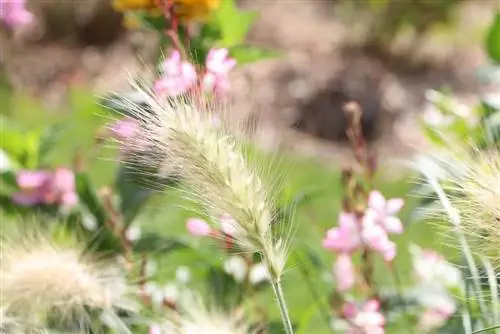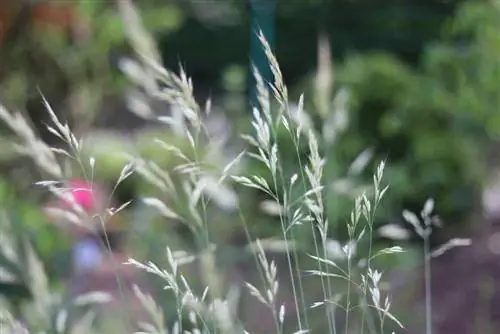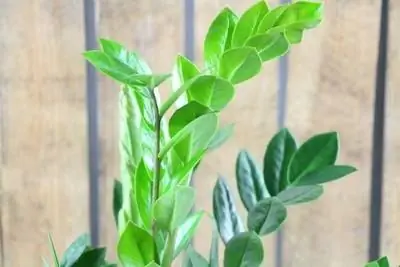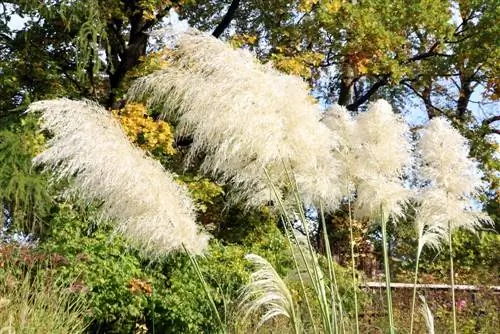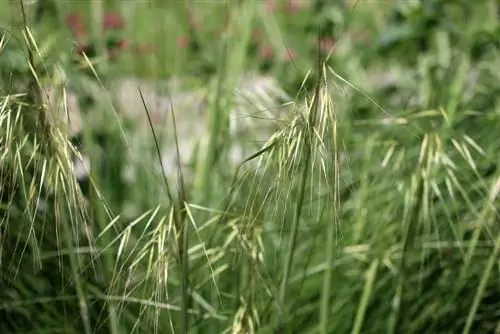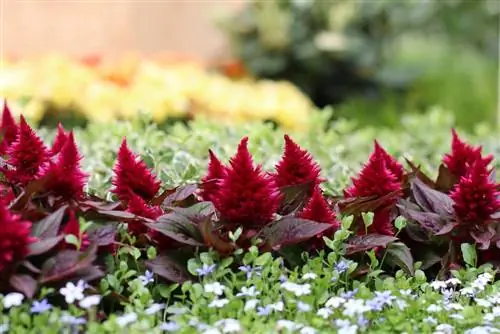- Author admin [email protected].
- Public 2023-12-17 03:39.
- Last modified 2025-01-24 12:45.
An attractive appearance and above-average resistance make feather bristle grass popular among many hobby gardeners. Whether planted in the garden bed or cultivated in a pot on the terrace or balcony, it is in any case quite undemanding to care for. Nevertheless, a few care points should be adhered to so that it thrives strong and he althy until late autumn.
Profile
- Name: Feather Bristle Grass
- Scientific name: Pennisetum alopecuroides
- Common names: Pipe cleaner grass, Pennisetum grass
- Genus: Pennisetum grasses (Pennisetum)
- Origin: East Asia to Australia
- Ornamental grass with false spikes
- Growth height: between 30 centimeters and 120 centimeters
- Flowering time: until late autumn/early winter
- Limescale tolerant
- Location: full sun to sunny
- Hardy: depending on variety
Location
Since the feather bristle grass is used to sunny plains due to its origin, this should definitely be taken into account when choosing a location. It should not be overshadowed by other plants, so planting it under trees should be avoided. In addition to strongly rooted plants such as trees, root competition could arise and limit the he althy growth of the Pennisetum grass. It feels particularly comfortable in a herbaceous bed, in open spaces, on pathsides or in front gardens as well as in rock gardens, but also in a pot on the terrace or balcony.
Otherwise, the optimal location for the ornamental grass should meet the following criteria:
- Sunny to full sun (at least four hours of direct sun daily)
- Optimal location facing south
- Warm, even midday heat
- lots of space to the side as it can grow very wide
- Wind and draft proof
Best planting time
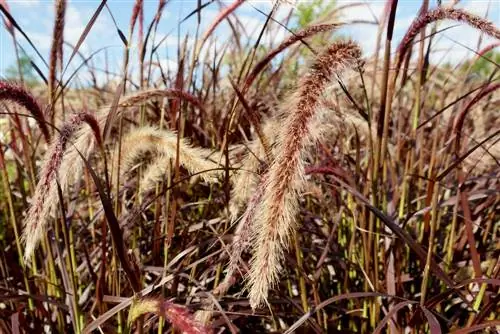
Spring is the best time for planting. Hardy varieties can be planted in the garden soil from the end of March on a frost-free day. For non-hardy specimens, you should wait until after the Ice Saints to plant them. If you would like to cultivate the feather bristle grass in a bucket, we recommend waiting until mid-May. The cold reaches the plant much more in pots than in the garden soil. Frost can cause frostbite even in newly cultivated hardy feather bristle grasses if they have not had enough time to set. Therefore, mid-May is generally considered the earliest time for cultivating in pots.
Soil texture
An important criterion for he althy, strong growth concerns the quality of the soil. This determines whether there is an adequate supply and how this ornamental grass thrives. If you stick to the following properties of the soil, the pennisetum grass will thank you with a long lifespan:
- Permeable
- Nutrient Rich
- Moderately dry to fresh and without waterlogging
- Preferably slightly sandy or clayey (prevents waterlogging)
- It tolerates low lime content
- pH value: slightly alkaline to slightly acidic
Substrate
If the feather bristle grass is planted in a pot, the pot soil should also have the properties already mentioned for outdoor planting. Particular attention must be paid to water permeability, as the risk of waterlogging in pots is significantly higher than in outdoor soil. For this reason, it is recommended to choose a substrate that also has coconut fibers or perlite.
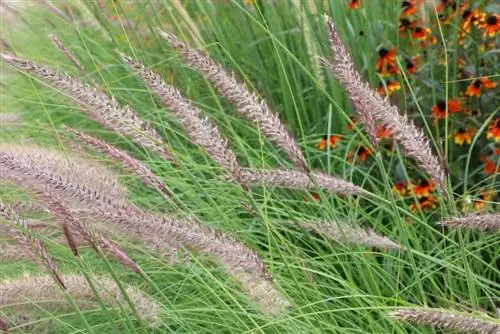
Basically, you can also take conventional potting soil and mix it yourself with coconut fiber, perlite or even gravel. Because cheap potting soil in particular tends to compact quickly, the additional material must be incorporated extensively and evenly. But even then there remains a higher residual risk, which is why you are generally better off with a high-quality substrate in the long term.
Plants
Outdoor planting
Only hardy Pennisetum alopecuroides should be planted outdoors. Since they can become heavily rooted, frost-sensitive plants can only be planted out in the fall with difficulty or not at all without damage in order to relocate them to winter quarters. Non-hardy feather bristle grasses are therefore not ideal for planting outdoors.
When planting outdoors, the best way to proceed is as follows:
- Planting hole depth/width: twice as large as the plant ball
- Planting distance: between 60 centimeters and 80 centimeters
- Lay a two centimeter thick layer of gravel or quartz sand at the bottom of the planting hole (drainage)
- Enrich the excavated soil with compost or fertilizer
- Spread a few centimeters of soil onto the drainage
- Place the plant ball so high that there is a distance of at least five to six centimeters from the surface of the soil
- Spread the remaining soil around and on the bale and press it down in layers (increases stability)
- Pour generously
pot planting
Planting in containers is similar to planting outdoors. It is important to ensure that the bucket is of sufficient size and has a drainage hole so that excess water can drain away. To avoid water stains on patio or balcony tiles, for example, we recommend using a coaster. Maintain a distance of at least two centimeters between the substrate surface and the edge of the container. This will prevent wet soil from spilling over after watering.
Repotting
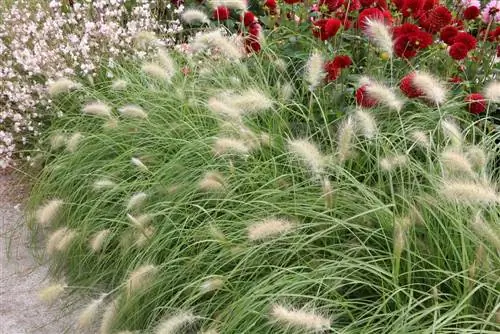
If the Pennisetum alopecuroides becomes too big for the pot, you will notice that it stagnates in growth and, in the worst case, even turns brown. As a rule, the roots force their way through the drainage hole. Here is the latest time to repot into a larger bucket. If the growth of the ornamental grass is to be restricted, the roots must be cut so that they have enough space in the old pot again. The substrate should be replaced with a new, fresh one during the process. Otherwise, repotting into fresh substrate every three to four years is usually sufficient.
Pouring
Moisture content
The feather bristle grass likes a moisture content between dry and slightly moist. It can't cope with waterlogging just as much as it can with permanent dryness. For this reason, you should always ensure a slight moisture content and water regularly. The water requirement increases, especially in summer in a sunny/full sun location. Nevertheless, even on the hottest summer days, it is enough to water once a day and to thoroughly wet the soil/substrate. When cultivating in pots with a saucer, you must remove any water that has run off after watering so that the ornamental grass does not remain in it and become waterlogged.
After planting/cultivating
Freshly planted and cultivated specimens should be kept slightly moist for the first two weeks so that the ornamental grass can settle better. The soil is then allowed to dry out for a short time, but never dry out.
Water quality
You should only use well-tempered, soft, lime-free water for irrigation. Pennisetum grasses do not tolerate cold water well. Rain or stale tap water is best used as irrigation water for feather-bristle grasses.
Fertilize
Pennisetum grasses are very frugal when it comes to their nutrient requirements. Fertilizing is not absolutely necessary, but should still be done under certain circumstances. This is the case if the Pennisetum alopecuroides has been growing in the same soil in an outdoor location for several years or if neighboring plants extract a lot of nutrients from the soil. You should then fertilize according to the following instructions:
- Use nutrient-rich compost, blue grain fertilizer or liquid complete fertilizer for green plants and perennials
- Fertilization time: spring and/or shortly before flowering begins in July
- Do not fertilize from September onwards
- Strictly adhere to the manufacturer's recommended dose to avoid over-fertilization
Cutting
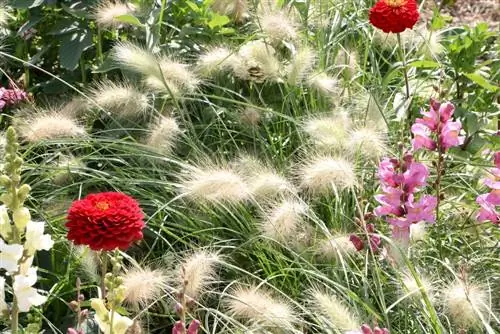
Due to its beautiful, uniform growth habit, feather bristle grass generally does not need to be cut, provided it is he althy and has sufficient space in all directions. If this is not the case and it grows too close to neighboring plants, cutting is necessary. A so-called maintenance cut, in which old, rotten or dried plant parts are cut off, should be carried out regularly.
When cutting, you should note the following:
- Never cut radically, this weakens the plant
- It is optimal if you limit yourself to cutting the tips of the stalk
- Maximum pruning: up to ten centimeters in length
- Optimal time for cutting: spring after the Ice Saints
- Remove dried or rotten stalks
- Never prune in autumn as this increases the risk of frostbite and rot
Wintering
The correct overwintering of pennisetum grasses depends on whether the respective variety is winter-hardy. Winter-hardy grasses can remain outdoors, while frost-sensitive plants should move into suitable winter quarters. When it comes to winter-hardy feather bristle grasses, it should be taken into account that they can only tolerate minus temperatures of around six degrees Celsius. If it gets colder, special precautions will protect you from frostbite.
To overwinter the ornamental grasses, you should proceed as follows:
- Tie hardy plants together from six degrees Celsius at the latest
- Cover with plant fleece, straw or brushwood (especially potted plants and in windy locations)
- Under no circumstances cut before the start of winter - increases the risk of rot and frostbite
- Let non-winter-hardy grasses overwinter in a frost-free, dark place
- For potted plants, regularly check the substrate for rot and mold and remove if necessary
- Make sure that the soil/substrate does not dry out completely
Propagate
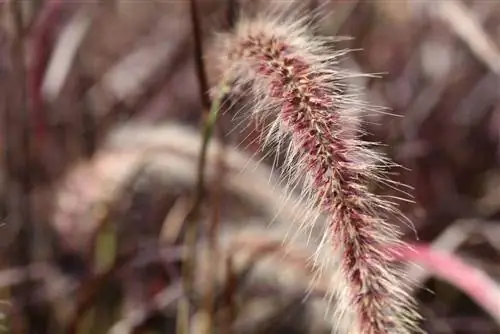
Would you like to have several feather bristle grasses in the garden or on the balcony inexpensively? In these cases it is worth propagating, which can easily be done by division. Regular division is recommended, especially for older plants that tend to turn brown or become matted. By dividing the roots, they gain strength and can grow vigorously again.
When dividing, proceed as follows:
- Plant out the plant ball in the spring after the last frost
- Divide the root ball into two, three or four areas depending on size and needs
- Plant all parts including the “mother plant” in the soil/pot as described under “Plants”
- Water generously and ensure constant soil moisture (no waterlogging) over the following two weeks
Tip:
If an ornamental grass is very light, you can help it grow larger again by dividing a fuller plant. To do this, simply plant a divided root area directly next to the light specimen, then they will quickly connect and a greater density will be achieved.
Diseases and pests
The feather bristle grass is usually a fairly inconspicuous plant when it comes to diseases and pests. Illnesses are mainly due to care errors.
Rust
Rust is a fungal disease. The Pucciniales thrives primarily on very moist ornamental grasses. It can be recognized by typical discoloration on the stalks, which can be in shades of yellow or red. Spore deposits form. The leaves die as the fungal infection progresses. Combating it is urgently recommended. In order not to waste time experimenting with possible home remedies, it is advisable to use a fungicide from a specialist store to kill the fungus as quickly as possible.
Rot
If you are too careful about watering or if, for example, stalks are broken during an autumn storm, this can trigger rot. This causes the stalks to soften and mold can form. Cut off all affected parts of the plant and ensure that the soil/substrate can dry out.
If the rot occurs in the fall, there is not much you can do. If you were to cut now, you would increase the risk of the rot spreading over a large area. For this reason, you should only limit yourself to drying the soil/substrate and, if there is additional mold growth, treat it with a fungicide. It is then only cut in the spring after frost. It may be necessary to cut it back to a height of ten centimeters so that the ornamental grass regains its strength.
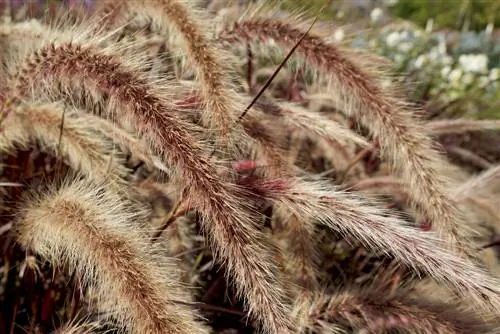
Spider mites
Spider mites like dry, warm air. The parasites, which are between 0.25 and 0.8 millimeters in size, can hardly be seen with the naked eye. Depending on the season and host species, they can be pale green, yellow-green, orange or reddish-brown in color. Clear signs of a spider mite infestation are yellow spots on the grass and white webs that can extend over the entire plant.
Environmentally friendly and effective ways to quickly get spider mites under control:
- Shower/spray the feather bristle grass vigorously
- Wrap the plant completely and, if possible, airtight in a translucent plastic wrap
- Leave the ornamental grass wrapped up for two to three days
- Then open the slide
- If spider mites are still visible, the process can be repeated
Varieties
Pennisetum alopecuroides 'Compressum'
- Australian feather bristle grass
- Growth height: between 70 and 120 centimeters
- blooms yellowish-brown in late summer
- moderately hardy
Pennisetum alopecuroides 'Hameln'
- Growth height: approx. 50 centimeters
- brown-red false ears
- Early bloomers
- hardy
Pennisetum alopecuroides ‘Japonicum’
- Japan Pennisetum
- Growth height: between 60 and 120 centimeters
- blooms yellow-brownish from late summer to late autumn
- moderately hardy
Pennisetum alopecuroides ‘Little Bunny’
- Dwarf Pennisetum
- Size between 10 and 30 centimeters
- roll-shaped false ears
- narrow growth habit of leaves and stalks
- moderately hardy
Pennisetum alopecuroides ‘Moudry’
- Growth height: up to 50 centimeters
- lush green foliage
- purple to black panicles
Pennisetum alopecuroides 'Weserbergland'
- Growth height between 40 and 70 centimeters
- yellow-brownish blooms from late summer to autumn
- moderately hardy

